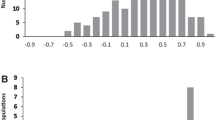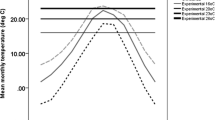Abstract
Eight isofemale lines ofDrosophila busckii were tested for emigration response behavior, using a modification of the Sakai system which permitted an analysis of two environmental variables, height and light. There was significant variation in the behavior of the isofemale lines in the four environmental configurations. Although there was no main effect of light on the emigration response of the isofemale lines, there was an effect of height. The isofemale lines differed in the overall pattern with which light and height affected their behaviors, indicating that, in this population ofDrosophila busckii, there is a varied and complex assemblage of genomes affecting emigration response behavior.
Similar content being viewed by others
References
Atkinson, W., and Shorrocks, B. (1977). Breeding site specificity in the domestic species ofDrosophila.Oecology 29:223–232.
Prakash, S. (1973). Low gene variation inDrosophila busckii.Genetics 75:571–576.
Rockwell, R. F. (1979). Emigration response behavior. II. The responses ofDrosophila busckii.Pan-Pac. Entomol. 55:117–126.
Rockwell, R. F. (1980). Photobehavioral differentiation in natural populations ofDrosophila: Changes of photoresponse over time inD. pseudoobscura andD. persimilis.Behav. Genet. 10:521–535.
Rockwell, R. F., and Barrowclough, G. (1986). Gene flow and population structure. In Cooke, F., and Buckley, P. (eds.),Avian Genetics, Academic Press, London.
Rockwell, R. F., and Levine, L. (1985). Chromosomal polymorphism and vagility in natural populations ofDrosophila pseudoobscura. In Huettel, M. (ed.),Evolutionary Genetics of Invertebrate Behavior, Plenum, New York.
Rockwell, R. F., and Seiger, M. B. (1973). Phototaxis inDrosophila: A critical evaluation.Am. Sci. 61:339–345.
Rockwell, R. F., Cooke, F., and Harmsen, R. (1975). Photobehavioral differentiation in natural populations ofD. pseudoobscura andD. persimilis.Berhav. Genet. 5:189–202.
Rockwell, R. F., Grossfield, J., and Levine, L. (1978). Emigration response behavior. I. Effects of height and light on the Oregon-R and norp-A strains ofDrosophila melanogaster.Egypt. J. Genet. Cytol. 7:123–136.
Sakai, K., Narise, Y., Hiraizumi, S., and Iyama, S. (1958). Studies on competition in plants and animals. IX. Experimental studies on migration inDrosophila melanogaster.Evolution 12:93–101.
Throckmorton, L. (1975). The phylogeny, ecology and geography ofDrosophila. In King, R. C. (ed.),Handbook of Genetics, Vol. 3, Plenum Press, New York.
Winer, B. J. (1971).Statistical Principles in Experimental Design, McGraw-Hill, New York.
Author information
Authors and Affiliations
Additional information
Supported in part by a grant from the City University of New York PSC-CUNY Research Award Program to RFR and by U.S. Department of Health and Human Services PHS Grant 2-SO7-RR07132 to LL.
Rights and permissions
About this article
Cite this article
Rockwell, R.F., Levine, L. Emigration response behavior: III. Genetic variability in a natural population ofDrosophila busckii . Behav Genet 16, 543–551 (1986). https://doi.org/10.1007/BF01066340
Received:
Accepted:
Issue Date:
DOI: https://doi.org/10.1007/BF01066340




